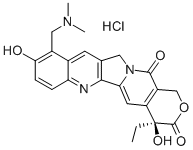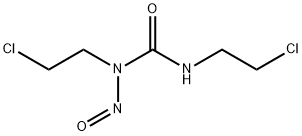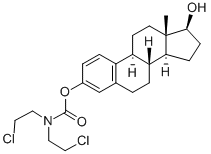Mechlorethamine hydrochloride , 98% , 55-86-7
Synonym(s):
NM;Nitrogen mustard;N-Methylbis(2-chloroethyl)amine hydrochloride;2-Chloro-N-(2-chloroethyl)-N-methylethanamine;Bis(2-chloroethyl)methylamine
CAS NO.:55-86-7
Empirical Formula: C5H12Cl3N
Molecular Weight: 192.51
MDL number: MFCD00012517
EINECS: 200-246-0
| Pack Size | Price | Stock | Quantity |
| 1g | RMB39.20 | In Stock |
|
| 5G | RMB109.60 | In Stock |
|
| 25G | RMB376.80 | In Stock |
|
| 100g | RMB1137.60 | In Stock |
|
| others | Enquire |
PRODUCT Properties
| Melting point: | 108-111 °C(lit.) |
| Boiling point: | 315.95°C (rough estimate) |
| Density | 1.4424 (rough estimate) |
| refractive index | 1.6300 (estimate) |
| storage temp. | −20°C |
| solubility | H2O: very soluble |
| form | Solid |
| pka | pKa 6.43 (Uncertain) |
| color | Leaflets from Me2CO or CHCl3 |
| Sensitive | Hygroscopic |
| Merck | 13,5798 |
| Stability: | Stable. Hygroscopic. |
| CAS DataBase Reference | 55-86-7(CAS DataBase Reference) |
| EPA Substance Registry System | Nitrogen mustard (HN-2), hydrochloride (55-86-7) |
Description and Uses
Nitrogen mustard (HN) was developed in three formulations: HN-1, HN-2, and HN-3. HN-1 was the first to be produced in the late 1920s and early 1930s. Originally, it was developed as a pharmaceutical and used to remove warts before it became a military agent. Agent H-2 was developed as a military agent and became a pharmaceutical. HN-3 was designed as a military mustard agent and is the only one that remains in military use. Therefore, this section will only cover the characteristics of HN-3 mustard agent. HN-3 is colorless to pale yellow with a butter-almond odor. The chemical formula for nitrogen mustard agent HN-3 is N(CH2CH2Cl)3. It will otherwise be ineffective against stopping the damage to the body.
xanthine oxidase/dehydrogenase inhibitor
Safety
| Symbol(GHS) |    GHS05,GHS06,GHS08 |
| Signal word | Danger |
| Hazard statements | H300+H310-H314-H340-H350-H360D |
| Precautionary statements | P202-P260-P280-P303+P361+P353-P304+P340+P310-P305+P351+P338 |
| Hazard Codes | T+ |
| Risk Statements | 45-46-28-34-42/43-27/28-61 |
| Safety Statements | 53-36/37/39-45 |
| RIDADR | UN 2811 6.1/PG 2 |
| WGK Germany | 3 |
| RTECS | IA2100000 |
| TSCA | Yes |
| HazardClass | 6.1(a) |
| PackingGroup | II |
| HS Code | 2921196190 |
| Hazardous Substances Data | 55-86-7(Hazardous Substances Data) |
| Toxicity | LD50 in rats (mg/kg): 1.1 i.v.; 1.9 s.c. (Anslow) |




